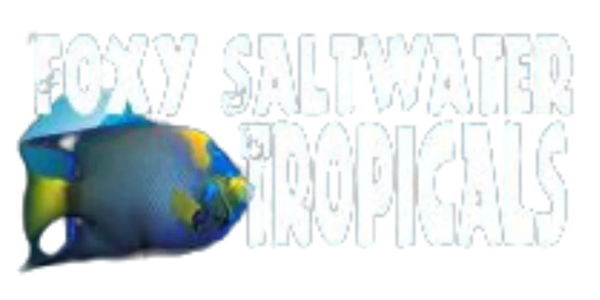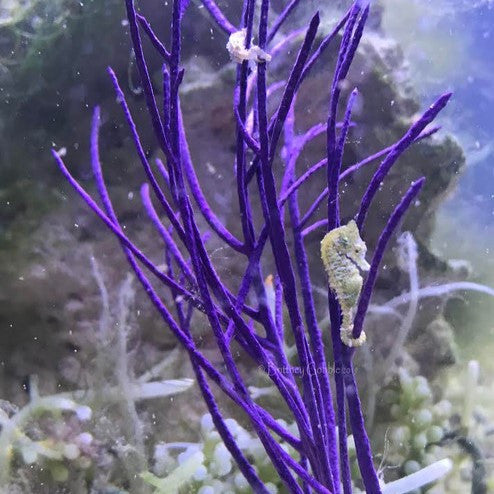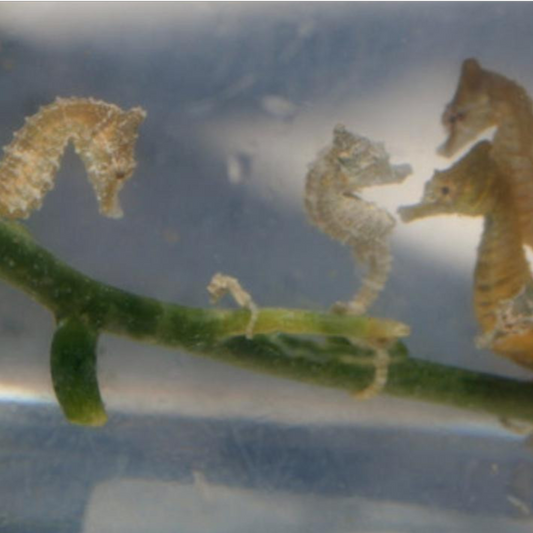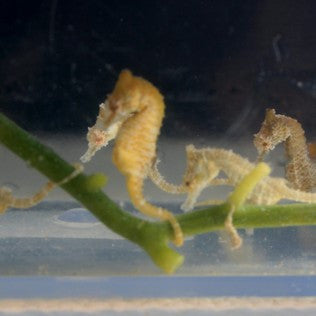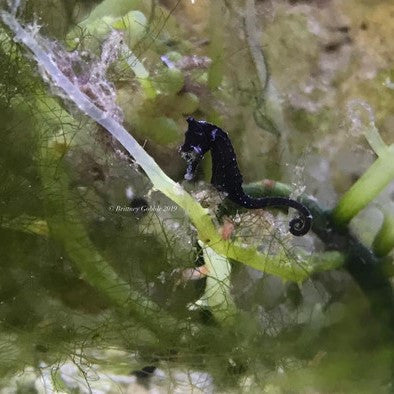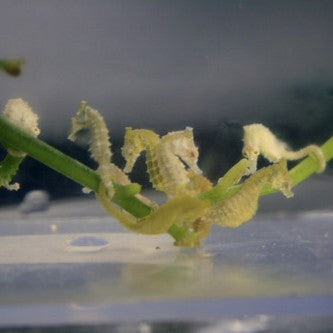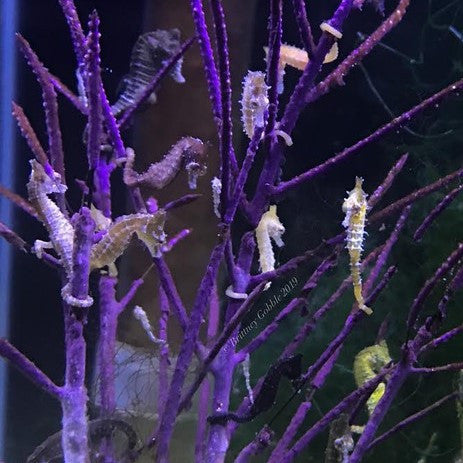Collection: Dwarf Seahorse
We recommend doing an ample amount of research prior to starting your Dwarf Seahorse tank. They require their own set of care and it is a bit different than typical saltwater tanks. We highly recommend purchasing a copy of The Complete Guide to Dwarf Seahorses in the Aquarium by Alisa Wagner Abbott. (Photo Below) We keep it on hand here in our shop and it has proved to be extremely helpful for us! It gives a lot of insight on starting and maintaining a Dwarf Seahorse tank.
Dwarf Seahorses, Hippocampus Zosterae, are about 1/2 to 1 1/2 inches. I recommend using a sponge filter (the low current saltwater is needed to avoid stressing them out). The general rule of thumb is 4 dwarf seahorses per 1 gallon of water. Good decoration for your saltwater aquarium could be Gorgonians, Sponges, and Macro Algae for them to grab with their prehensile tail. Use caution with live rock or sand because it could have stinging animals. They are NOT REEF SAFE!!! Corals may burn them (Gorgonian Coral will not burn them). Some tank mates consist of Snails, small Hermits, Starfish, and Pipefish. Be careful and use caution when adding tank mates that will out compete them for food.
Dwarf seahorses eat Tigger Pods, newly hatched brine shrimp, copepods, and other shrimp larvae. Dwarf seahorses can breed in a home aquarium if they receive at least 12 hours of light. The mating ritual consists of some dancing, shaking and maybe even a change in colors. When the female's eggs are ready she will insert them in the male seahorses pouch. It takes about 2 weeks for the male seahorse to birth 10-30 fry. The babies will also eat the Tigger Pods and baby brine shrimp. The babies will double their size in just over 2 weeks and after 3 months will be ready to mate.
A few pointers:
- The general rule of thumb is 4 Dwarf Seahorses per 1 gallon of water. They do best in larger groups versus small pairs. They are also polygamous and may have many mates, whereas the Common Seahorses have 1 mate for their entire lifetime. Pretty neat!
- It is best to keep the horses in a tank that is 12 gallons or less. Any larger and the horses will not hunt their food during feedings.
-
We find that frozen brine shrimp is too large for their small mouths. Instead, we feed our Dwarfs Tigger Pods (now available on our site), and/or hatched brine shrimp eggs. We purchase our brine shrimp eggs from Brineshrimpdirect.com. They also sell the hatching equipment.
- It is recommended to cycle the tank for a minimum of 1 month (the longer the better) prior to introducing any horses into the tank.
- The tank should be anemone and coral free (aside from Gorgonians). The Anemones and Corals can sting, injure, and potentially kill the seahorses.
-
Gorgonians make for great hitching posts for the seahorses. Caulerpa is another great option for hitching posts. You can also add artificial decorations/hitching posts if you prefer.
- If your seahorses give birth in your tank, you can keep the baby Dwarf Seahorses in the same tank and feed them the same as you feed the adults.
Some additional pointers include:
Tank Conditions:
Temperature: 70-80 F
Salinity: 1.018-1.022 (1.019 is optimum)
pH: 8.2-8.4
Ammonia: 0
Nitrite: 0
Nitrate: 0-.10ppm
Lighting:
Up to your personal preference - 15-watt bulbs is plenty for a 10 gallon tank.
Intense lighting is not recommended.
Water Changes:
10 Gallon tanks do well with monthly water changes and add fresh water weekly.
In a smaller tank you will need to do more frequent water changes.
Tank Mates:
While it is recommended to keep the tank a species only tank, the following items are seahorse friendly (with caution):
- Pipefish
- Dwarf Pipefish
- Diamond Watchman Goby
- Red Firefish
- Purple Firefish
- Blue Mandarin Goby
- Spotted Mandarin Goby
- Royal Gramma Basslet
- Black Cap Basslet
- Chalk Basslet
- Pajama Cardinal
- Flame Cardinal
- Aiptasia Eating Filefish
- Clownfish (either A. ocellaris or A. percula)
- Molly Miller Blenny
You can either create your own clean up crew on our website or purchase a 15 gallon clean up crew (with crabs) or a crabless clean up crew.

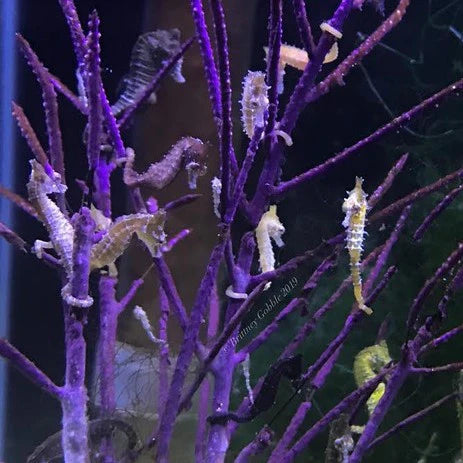 Sold out
Sold out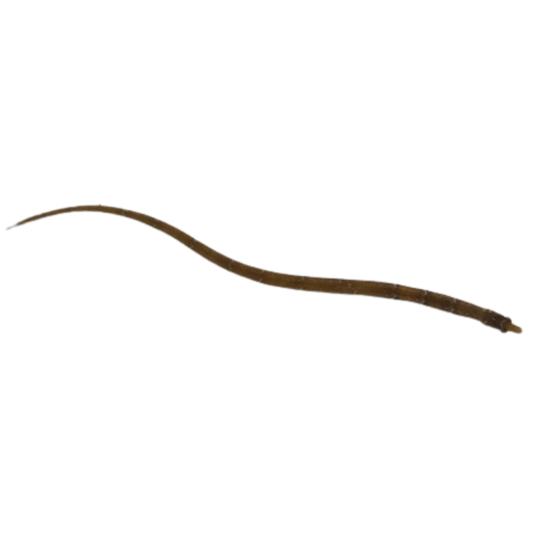 Sold out
Sold out